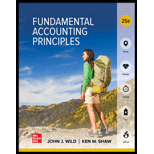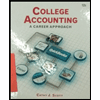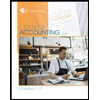
a
Concept Introduction:
Pledging receivables: A business can borrow money by pledging its receivables as collateral. Since the borrower retains ownership of the receivables, pledging does not transfer the risk of
The
b
Concept Introduction:
Pledging receivables: A business can borrow money by pledging its receivables as collateral. Since the borrower retains ownership of the receivables, pledging does not transfer the risk of bad debts to the lender. If the borrower defaults, the lender will receive cash from the collected receivables.
The transaction that would require a note to the financial statement.
Want to see the full answer?
Check out a sample textbook solution
Chapter 9 Solutions
FUND.ACCT.PRIN.
- Samuel Manufacturing wishes to earn an after-tax net income of $30,000. Total fixed costs are $85,000, and the contribution margin per unit is $6.80. Samuel’s tax rate is 40%. What is the number of units that must be sold to earn the targeted net income?arrow_forwardPlease provide the accurate answer to this general accounting problem using appropriate methods.arrow_forwardWhat was the sales price per unit?arrow_forward
- I am looking for help with this general accounting question using proper accounting standards.arrow_forwardFinancial Accounting Question Solution Please Provide Solution Without Ai and Copy past if Give Wrong Answer I give Unhelpfularrow_forwardPlease provide the correct answer to this general accounting problem using valid calculations.arrow_forward
- HELParrow_forwardCan you help me solve this accounting problem with the correct methodology?arrow_forwardEcho Industries uses a single raw material in its production process. The standard price for a unit of material is $2.25. During the month, the company purchased and used 820 units of this material at a price of $2.10 per unit. The standard quantity required per finished product is 4 units, and during the month, the company produced 205 finished units. How much was the material price variance?arrow_forward
 Cornerstones of Financial AccountingAccountingISBN:9781337690881Author:Jay Rich, Jeff JonesPublisher:Cengage LearningPrinciples of Accounting Volume 1AccountingISBN:9781947172685Author:OpenStaxPublisher:OpenStax College
Cornerstones of Financial AccountingAccountingISBN:9781337690881Author:Jay Rich, Jeff JonesPublisher:Cengage LearningPrinciples of Accounting Volume 1AccountingISBN:9781947172685Author:OpenStaxPublisher:OpenStax College College Accounting (Book Only): A Career ApproachAccountingISBN:9781305084087Author:Cathy J. ScottPublisher:Cengage Learning
College Accounting (Book Only): A Career ApproachAccountingISBN:9781305084087Author:Cathy J. ScottPublisher:Cengage Learning College Accounting, Chapters 1-27AccountingISBN:9781337794756Author:HEINTZ, James A.Publisher:Cengage Learning,
College Accounting, Chapters 1-27AccountingISBN:9781337794756Author:HEINTZ, James A.Publisher:Cengage Learning, College Accounting, Chapters 1-27 (New in Account...AccountingISBN:9781305666160Author:James A. Heintz, Robert W. ParryPublisher:Cengage Learning
College Accounting, Chapters 1-27 (New in Account...AccountingISBN:9781305666160Author:James A. Heintz, Robert W. ParryPublisher:Cengage Learning Survey of Accounting (Accounting I)AccountingISBN:9781305961883Author:Carl WarrenPublisher:Cengage Learning
Survey of Accounting (Accounting I)AccountingISBN:9781305961883Author:Carl WarrenPublisher:Cengage Learning





